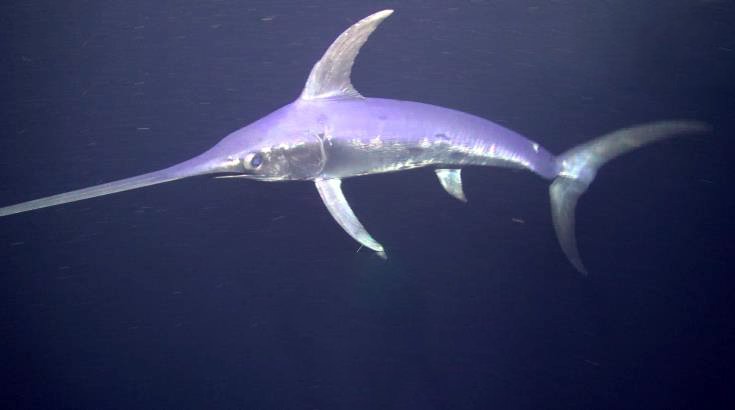10 Fascinating Swordfish Fun Facts + FAQ
Quick, interesting, fun facts – Did you know that swordfish:

3.8 m and 345 kg.
- Use their sword-like snout to slash and stun prey.
- Can swim up to 50-60 miles per hour, and some claim up to 80 mph.
- Are not aggressive toward humans.
- Migrates and can travel thousands of miles every year
- Do not have scales after maturity.
- Live in warm waters worldwide.
- Are highly valued as a food source for steaks, sashimi, and other dishes.
- Can grow as big as 14 feet in length and weigh over 1000 pounds.
- Can live for up to nine years.
- Females are larger than males.
What is a swordfish?
A swordfish (xiphias gladius) is a large billfish that lives in the open ocean in warm temperate waters around the world. It has a long, flat bill that looks like a sword, and its body can grow up to 14 feet long and weigh up to 1,400 pounds.
The swordfish is known for its speed and agility, allowing it to hunt fast-moving prey such as squid, mackerel, tuna, and other fish.
Swordfish are classified in the family xiphiidae, a highly migratory species because they travel widely in search of food. They have been fished commercially for centuries and are considered an important food source for many cultures worldwide. Swordfish are also popular with sports fishermen who prize their fighting spirit when hooked on a line.
Ocean Habitat

Swordfish migrate in tropical waters across the globe, in the Mediterranean, the Pacific, and the Atlantic oceans near the equator. They prefer to live in the open ocean or coastal areas where the surface water is close to 75 degrees Fahrenheit or 24 degrees Celsius.
When the water gets colder during winter, they migrate to warmer waters, and some travel several thousand miles yearly. They take advantage of the various fish and resources as they move between regions.
Swordfish can swim as deep as 3,000 feet or 914 meters but primarily stay closer to the surface, in depths of 0-200 meters or 0-650 feet.
Fish Reproduction & Lifespan
Swordfish reproduce by spawning, where the female lays more than a million eggs (some sources claim from 1 million to 29 million eggs) in the water, and the male fertilizes them with sperm.
It takes about two to three days for the fertilized eggs to develop into embryos; after two weeks, they hatch and become free-swimming pups.
Swordfish live around nine years on average but can live as long as 25 years. They grow fast in the first year, grow slower as they age, and reach maturity after 4-5 years.
North Atlantic swordfish vs. marlin

The difference between swordfish and marlin is their size, bill, and flesh.
- Size: Swordfish can reach up to 14 feet and 1,400 pounds, have a flat, broad bill to slash prey, and have softer flesh.
- Marlin reaches up to nine feet and 500 pounds, has a spear-like bill used to stab prey and has firmer flesh.
Swordfish vs. Mahi Mahi
Swordfish and Mahi Mahi differ in size, weight, habitat, and meat flavor.
- Swordfish is a large, predatory fish found in temperate and tropical waters and can weigh up to 1,000 pounds, measure up to 14 feet in length, and has a milder and sweeter flavor.
- Mahi Mahi is a smaller, brightly-colored fish found in tropical waters near reefs and seamounts that typically weigh between 8-20 pounds and grow up to 4 feet in length., and has a firmer and savory taste.
Swordfish vs. salmon
Swordfish and salmon differ in habitat, size, meat texture, and nutrition.
- They are two of the most popular fish consumed worldwide and are excellent protein sources.
- Swordfish is enormous, weighing up to 400 pounds, has a firmer texture and milder taste, and contains more fat, cholesterol, vitamins, and minerals, including selenium, zinc, phosphorus, and vitamin B2.
- Salmon usually weigh 5-10 pounds but can grow to 20+ pounds. It has a softer flesh and sweeter taste and has higher contents of omega-3 fatty acids.
Swordfish vs. narwhal
The difference between swordfish and narwhal is their scientific classification, habitat, appearance, and diet, and their similarities are that they are both predatory sea creatures.
- Swordfish’s habitat is in warm tropical waters. It belongs to the Xiphidae family and has long, flat bills and a dorsal fin. They grow to 1-3 m and weigh up to 400 kg, and feed on cod, herring, and squid,
- Narwhals’ habitat is cold arctic waters. They belong to the Monodontidae family and have a unique spiral tusk extending from their upper lip. They grow up to 6 meters and weigh up to 1500 kg, and feed on halibut, cod, shrimp, and cuttlefish.
Frequently Asked Questions

How does swordfish taste? Does it taste good?

Swordfish have a mild, slightly sweet flavor with a firm yet tender texture.
They can be grilled, broiled, pan-fried, baked, steamed, or eaten raw. Most people find it to be a tasty fish.
What is the world record for the largest swordfish ever caught?
The world record is 1,182 pounds (534.7 kilograms), and it measured 11.3 feet (3.45 meters) in length, caught by Alfred Dean in Australia in 1959.
Is swordfish healthy?

Yes, swordfish is a healthy choice for seafood, with an excellent source of lean protein and omega-3 fatty acids, vitamins and minerals, selenium, vitamin B12, and niacin. And eating swordfish in moderation can be a part of a balanced diet.
Does swordfish have mercury?
Yes, swordfish contain mercury, and its mercury concentrations vary depending on the size, age, and species of the swordfish.
Larger and older swordfish are more likely to have high mercury levels.
Eating swordfish should be done in moderation to reduce the risk of mercury poisoning.
Does swordfish have scales?

No, adult swordfish does not have scales, and its skin is smooth and slimy. Its smooth surface helps the fish reduce drag while swimming.
Can you eat swordfish raw?
Yes, you can eat raw swordfish, which is a popular way of enjoying the fish, but it must be handled and prepared correctly to avoid the risk of foodborne illness. There is always a risk of getting sick from eating raw seafood.
Where do swordfish live?
Swordfish are found in all major oceans worldwide in tropical and temperate regions, including the Mediterranean, Pacific, and Atlantic Oceans. They prefer deep, open, and warm waters and can dive to depths of up to 1000 meters.
How to catch a swordfish?

Use a fishing rod with a heavy line and locate the swordfish by looking for the telltale triangle fin on the water’s surface. Then attach a live bait and release it into the water. Please wait for the fish to bite, then slowly reel it in. It is powerful and heavy, so be prepared for a fight.
How many swordfish are left in the world?
Nobody knows the exact number of swordfish left in the world, but estimates suggest that the number is decreasing. The International Union for Conservation of Nature (IUCN) lists swordfish as near threatened (NR) due to overfishing. According to the World Wildlife Fund, the global population is estimated to have declined by 50-70% since 1950.
Are swordfish endangered?
No. The IUCN classifies swordfish as declining and near threatened (NR). Their populations have been declining due to overfishing, so conservation efforts are essential to ensure long-term sustainability.
Can you eat swordfish during pregnancy and breastfeeding?

Pregnant and breastfeeding women should avoid eating swordfish due to the risk of mercury contamination, as mercury levels can harm the developing baby. Fish with lower levels of mercury, such as salmon and other small young fish, are generally considered safe to eat during pregnancy and breastfeeding.
Are swordfish dangerous, and do they attack humans?

Swordfish have attacked humans, and injuries from swordfish attacks range from minor to severe, but experts believe most cases to be provoked or defensive.
People should be careful when swimming in areas where swordfish are present, as they have sharp bills that can inflict severe wounds.
How to draw a swordfish?

Gather the materials needed to draw a swordfish: paper, pencil, and eraser.
Start sketching the shape of the head and body and the long, sharp sword-like snout.
Then add details to the head and body, such as the dorsal and pectoral fins, eyes, and mouth.
Outline the entire shape of the fish using a pencil, making the sword-like snout sharp and distinct.
Add shading and color to the drawing, using a pencil or paint, to finish the picture.
Do swordfish lay eggs?
Yes. Female swordfish lay millions of small and buoyant eggs in the open ocean, fertilized by the male’s sperm.
Does swordfish have worms?

Swordfish may contain parasites or worms, mostly nematodes such as Hysterothylacium Petteri and Anisakis Pegreffii. Consuming these parasites can cause digestive issues such as gastroenteritis, stomach pain, vomiting, constipation, diarrhea, and nausea. To reduce the risk of encountering these parasites, purchase swordfish from a reputable source, and use proper freezing, storing, and cooking techniques.
Does swordfish have bones?

Yes, swordfish have bones, but their meat is often boneless. The skeleton and bones go through the center of the fish, surrounded by a thick, fleshy muscle mass. It’s easy to fillet boneless meat.

